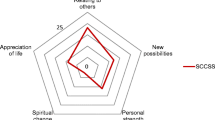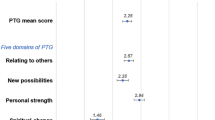Abstract
Sixty young adult survivors of a serious childhood illness completed quantitative and qualitative measures assessing the relationship between specific disease and distress factors and posttraumatic growth (PTG). Individuals who had recovered from their illness reported greater growth than those who were currently experiencing their illness. The regression model accounted for 47% of the variance in PTG, with perceived severity, illness status, and posttraumatic stress symptoms emerging as significant predictors. Qualitative analyses identified salient positive and negative factors associated with having had an illness, such as a positive shift in perspective and frequent medical requirements. Being past the daily demands of illness management may allow for greater PTG. Realization of positive aspects of having had an illness may require prompting.
Similar content being viewed by others
References
Ai, A. L., & Evans-Campbell, T. (2006). Faith, attitudes, mental health and personal growth following the 9/11 terrorism attacks. In S. D. Ambrose (Ed.), Religion and psychology: New research (pp. 73–106). New York: Nova Science Publishers.
Barakat, L., Alderfer, M., & Kazak, A. (2006). Posttraumatic growth in adolescent survivors of cancer and their mothers and fathers. Journal of Pediatric Psychology, 31, 413–419.
Best, M., Streisand, R., Catania, L., & Kazak, A. (2001). Parental distress during pediatric leukemia and posttraumatic stress symptoms (PTSS) after treatment ends. Journal of Pediatric Psychology, 26, 299–307.
Calhoun, L. G., & Tedeschi, R. G. (1999). Facilitating posttraumatic growth: A clinician’s guide. Mahwah, NJ: Lawrence Erlbaum.
Charmaz, K. (2008). Grounded theory. In J. A. Smith (Ed.), Qualitative psychology: A practical guide to research methods (pp. 81–110). Los Angeles: SAGE Publications.
Chun, S., & Lee, Y. (2008). The experience of posttraumatic growth for people with spinal cord injury. Qualitative Health Research, 18, 877–890.
Cohen, J. (1977). Statistical power analysis for the behavioural sciences. New York: Academic Press.
Cohen, J. (1992). A power primer. Psychological Bulletin, 112, 155–159.
Cordova, M. J., & Andrykowski, M. A. (2003). Responses to cancer diagnosis and treatment: Posttraumatic stress and posttraumatic growth. Seminar in Clinical Neuropsychiatry, 8, 286–296.
Cordova, M. J., Cunningham, L., Carlson, C., & Andrykowski, M. (2001). The posttraumatic growth following breast cancer: A controlled comparison study. Health Psychology, 20, 176–185.
Cordova, M. J., Giese-Davis, J., Golant, M., Kronenwetter, C., Chang, V., & Spiegel, D. (2007). Breast cancer as trauma: Posttraumatic stress and posttraumatic growth. Journal of Clinical Psychology in Medical Settings, 14, 308–319.
Evers, A., Kraaimaat, F., van Lankveld, W., Jongen, P., Jacobs, J., & Bijlsma, W. J. (2001). Beyond unfavorable thinking: The Illness Cognition Questionnaire for Chronic Diseases. Journal of Consulting and Clinical Psychology, 69, 1026–1036.
Fleiss, J. L. (1981). Statistical methods for rates and proportions. New York: Wiley.
Fromm, K., Andrykowski, M. A., & Hunt, J. (1996). Positive and negative life psychosocial sequelae of bone marrow transplantation: Implications for quality of life assessment. Journal of Behavioral Medicine, 19, 221–240.
Glaser, B. G., & Strauss, A. L. (1967). The discovery of grounded theory. Chicago: Aldine.
Horowitz, M. (1991). Person schemas. In M. Horowitz (Ed.), Person schemas and maladaptive interpersonal patterns (pp. 13–31). Chicago: University of Chicago Press.
Linley, P. A., & Joseph, S. (2004). Positive change following trauma and adversity: A review. Journal of Traumatic Stress, 17, 11–21.
Milam, J. E., Ritt-Olson, A., & Unger, J. (2004). Posttraumatic growth among adolescents. Journal of Adolescent Research, 19, 192–204.
Morrill, E., Brewer, N., O’Neill, S., Lillie, S., Claire Dees, E. E., Carey, L. A., et al. (2008). The interaction of post-traumatic growth and posttraumatic stress symptoms in predicting depressive symptoms and quality of life. Psycho-Oncology, 17, 948–953.
Park, C. L., Cohen, L. H., & Murch, R. (1996). Assessment and prediction of stress-related growth. Journal of Personality, 64, 71–105.
Pless, I. B., & Pinkerton, P. (1975). Chronic childhood disorders: Promoting patterns of development. Chicago: Year Book Medical Publishers.
Sheikh, A. (2004). Posttraumatic growth in the context of heart disease. Journal of Clinical Psychology in Medical Settings, 11, 265–273.
Stein, R. E., & Jessop, D. J. (1982). A noncategorical approach to chronic childhood illness. Public Health Reports, 97, 354–362.
Taïeb, O., Moro, M. R., Baubet, T., Revah-Lévy, A., & Flament, M. F. (2003). Posttraumatic stress symptoms after childhood cancer. European Child and Adolescent Psychiatry, 12, 255–264.
Tedeschi, R. G., & Calhoun, L. G. (1996). The Posttraumatic Growth Inventory: Measuring the positive legacy of trauma. Journal of Traumatic Stress, 9, 455–470.
Tedeschi, R. G., & Calhoun, L. G. (2004). Posttraumatic growth: Conceptual foundations and empirical evidence. Psychological Inquiry, 15, 1–18.
Weiss, T. (2004). Correlates of posttraumatic growth in married breast cancer survivors. Journal of Social and Clinical Psychology, 23, 733–746.
Weiss, D., & Marmar, C. (1997). The Impact of Event Scale—Revised. In T. Wilson & J. Keane (Eds.), Assessing psychological trauma and PTSD (pp. 399–411). New York: Guilford Press.
Acknowledgments
We thank Jordan L. Gilleland, Megan McCormick, Melissa Mims, Mary Payne, Patrick Gauld, Ashley Beatty, and Megan McCay for their efforts in coding the qualitative data presented in this study.
Author information
Authors and Affiliations
Corresponding author
Rights and permissions
About this article
Cite this article
Devine, K.A., Reed-Knight, B., Loiselle, K.A. et al. Posttraumatic Growth in Young Adults Who Experienced Serious Childhood Illness: A Mixed-Methods Approach. J Clin Psychol Med Settings 17, 340–348 (2010). https://doi.org/10.1007/s10880-010-9210-7
Published:
Issue Date:
DOI: https://doi.org/10.1007/s10880-010-9210-7




